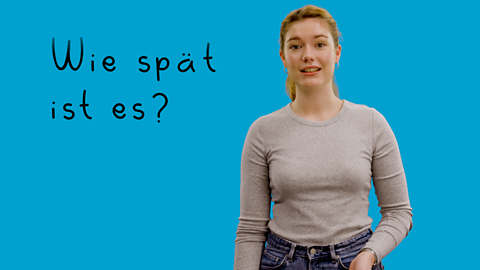Talking about your family in German
**Wer ist in deiner Familie?**Whoâs in your family?
Hier ist meine Familie. Hereâs my family.
Letâs start with my mother, meine Mutter, and my father, mein Vater.
When you say âmyâ in German you use meine for feminine nouns - meine Mutter and mein for masculine nouns - mein Vater.
Or meine Schwester, my sister, and mein Bruder, my brother.
Ich habe eine Schwester und einen Bruder. - I have a sister and a brother.
In German thereâs a word for brothers and sisters - die Geschwister.
Meine Gescwhister sind Àlter als ich - My brother and sister are older than me.
Meine Eltern sind geschieden - My parents are divorced.
Ich wohne mit meiner Mutter under meinem Stiefvater - I live with my mother and my stepfather.
Das is meine Familie- thatâs my family.

Your family
To talk about who is in your family, use the verb haben (to have), for example âI have a brotherâ. To do this, you need to use the right indefinite article. The indefinite article is a or an. In German, einen is used for male family members and eine is used for female family members. For example:
- Ich habe eine Mutter und einen Vater - I have a mother and a father.
- Ich habe einen Bruder - I have a brother.
- Ich habe zwei ČŃĂŒłÙłÙ±đ°ù - I have two mothers.
- Ich habe eine Mutter, einen Stiefvater, eine Schwester und einen Halbbruder - I have a mother, a step-father, a sister and a half-brother.
If you donât have any brothers or sisters, you can say:
- Ich habe keine Geschwister - I have no brothers and sisters.
- Ich bin Einzelkind - I am an only child.

Can you say who is in your family using the vocabulary below?
| German | English |
|---|---|
| Mutter / ČŃĂŒłÙłÙ±đ°ù | mother / mothers |
| Vater / łŐĂ€łÙ±đ°ù | father / fathers |
| Mama | mum |
| Papa | dad |
| Schwester / Schwestern | sister / sisters |
| Bruder / ”ț°ùĂŒ»ć±đ°ù | brother / brothers |
| Onkel | uncle |
| Tante | aunt |
| łÒ°ùŽÇñčČčłÙ±đ°ù | grandfather |
| Opa | grandad |
| łÒ°ùŽÇĂłŸłÜłÙłÙ±đ°ù | grandmother |
| Oma | granny |
| Cousin / Cousins | cousin (male) / cousins (male) |
| Cousine / Cousinen | cousin (female) / cousins (female) |
| Stiefmutter | step-mother |
| Stiefvater | step-father |
| Stiefschwester | step-sister |
| Stiefbruder | step-brother |
| Halbschwester | half-sister |
| Halbbruder | half-brother |
| keine Geschwister | no brothers or sisters |
| Eltern | parents |
| Pflegemutter | foster mother |
| Pflegevater | foster father |
Describing your family
You can describe your family in more detail by saying their name, age and where they live. Use the verbs: łó±đŸ±Ă±đČÔ (to be called), sein (to be) and wohnen (to live).
When talking about a family member, conjugate the verb into the third person (er/sie/es - he/she/it). The verb will end in t. This is the present tense. Conjugate means changing the endings of a verb to match the person doing the action.
- Mein Bruder łó±đŸ±ĂłÙ Paul - My brother is called Paul.
- Mein Vater ist fĂŒnfundvierzig Jahre alt - My father is 45 years old.
- Meine Mutter wohnt in Brighton - My mother lives in Brighton.
To talk about more than one family member, you need to use meine. For plural family members, most verbs end in -en. Don't forget that sein (to be) is an irregular verb: sie sind means they are.
- Meine Eltern heiĂen Leanne und Carla - My parents are called Leanne and Carla.
- Meine Schwestern wohnen in Birmingham - My sisters live in Birmingham.
- Meine ”ț°ùĂŒ»ć±đ°ù sind elf und sechzehn Jahre alt - My brothers are 11 and 16 years old.

Talking about family relationships
Ich komme gut mit ⊠aus is a phrase you can use to say you get on well with someone. You can change gut to nicht gut if you donât get on with them! When using this phrase, you have to change mein to meinem and meine to meiner after mit (with).
- Ich komme gut mit meinem Bruder aus - I get on well with my brother.
- Ich komme gut mit meiner Mama aus - I get on well with my mum.

Adding denn (because) allows you to give a reason for your opinion.
- Ich komme nicht gut mit meinem Cousin aus, denn er ist nervig - I donât get on well with my cousin because he is annoying.
- Ich komme nicht gut mit meiner Schwester aus, denn sie ist sehr laut - I donât get on well with my sister because she is very loud.
Can you write your own sentences using the vocabulary in the table below?
| German | English |
|---|---|
| ich komme gut mit ⊠aus | I get on well with ⊠|
| ich komme nicht gut mit ⊠aus | I don't get on well with ⊠|
| lustig | funny |
| nett | nice |
| sympathisch | sympathetic |
| Č”°ùŽÇĂłúĂŒČ”Ÿ±Č” | generous |
| ehrlich | honest |
| nervig | annoying |
| laut | loud |
Your pets
Pets are often part of the family, so you might want to talk about them too! Like with family members, you need to pay attention to the gender of the noun and check if it is masculine, feminine or neuter. Itâs not as simple as if your pet cat is male or female. To say a after ich habe you will need einen (masculine), eine (feminine) or ein (neuter). For example:
- Ich habe einen Hund - I have a dog.
- Ich habe eine Katze - I have a cat.
- Sie hat ein Kaninchen - She has a rabbit.
- Ich habe keine Haustiere - I have no pets.
Take a look at this slideshow to find more pets in German!

Image caption, der Hund - the dog
1 of 9
Plural pets
But what if you have more than one pet? You canât simply add an s on the end like in English. Plurals in German have different endings depending on the noun. Masculine and neuter nouns often add an e and feminine nouns often add an n.
- Ich habe zwei Hunde - I have two dogs.
- Ich habe drei Pferde - I have three horses.
- Er hat vier Katzen - He has four cats.
- Sie hat acht Spinnen - She has eight spiders.
There are some exceptions to this rule:
- Nouns that end in -chen stay the same. They are often neuter.
- Ich habe zwei Kaninchen - I have two rabbits.
- Ich habe sieben Meerschweinchen - I have seven guinea pigs.
- Hamster stays the same regardless of how many you have:
- Ich habe sechs Hamster - I have six hamsters.
- Some nouns add an umlaut (two dots) over the vowel and an e at the end:
- Ich habe vier ČŃĂ€łÜČő±đ - I have four mice.
Here are some plural pets:
| German | English |
|---|---|
| Hunde | dogs |
| Katzen | cats |
| Kaninchen | rabbits |
| Hamster | hamster(s) |
| ČŃĂ€łÜČő±đ | mice |
| Pferde | horses |
| Meerschweinchen | guinea pigs |
| Spinnen | spiders |
Ich habe vier ČŃĂ€łÜČő±đ - I have four mice.
Quiz
Find out how much you know about family and pets in German in this short quiz!
Game - FestiLingo: German. game
Visit the festival and practise German language skills in this game

More on Topics
Find out more by working through a topic
- count4 of 9

- count5 of 9

- count6 of 9
